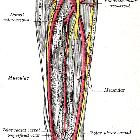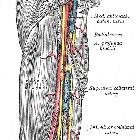Arteria ulnaris





The ulnar artery is a terminal branch of the brachial artery, arising at the proximal aspect of the forearm. Along with the radial artery, it is one of the main arteries of the forearm.
Summary
- origin: terminal branch of the brachial artery
- location: inferior aspect of the cubital fossa
- supply: elbow joint, medial and central forearm muscles, median and ulnar nerves, and common flexor sheath
- main branches: anterior and posterior ulnar recurrent arteries, common interosseous artery, palmar carpal arch, superficial palmar arch, and dorsal carpal branch
Gross anatomy
Origin
The ulnar artery arises as a large terminal branch of the brachial artery at the inferior aspect of the cubital fossa .
Course
The ulnar artery courses along the ulnar aspect of the forearm deep to the flexor muscles. It then enters the hand after passing through the Guyon canal (ulnar canal) located between the pisiform and the hook of hamate. It then divides into its terminal branches at the carpal region of the hand .
Branches
The main branches of the ulnar artery include the anterior and posterior ulnar recurrent arteries, the common interosseous, the palmar carpal arch, the superficial palmar arch, and the dorsal carpal branch .
Termination
The ulnar artery terminates at the hand via its branches; the palmar carpal arch, the superficial palmar arch, and the dorsal carpal branch .
Supply
The ulnar artery supplies the periarticular anastomoses of the elbow via the anterior and posterior ulnar recurrent arteries. It also supplies the medial and central forearm muscles, the median and ulnar nerves, and the common flexor sheath .
Variant anatomy
There may be a persistent median artery from the common or anterior interosseous arteries which accompanies the median nerve through the carpal tunnel.
Related pathology
Siehe auch:
- Arteria brachialis
- Arteria radialis
- Arcus palmaris superficialis
- Arteria interossea anterior
- Arteria interossea posterior
und weiter:

 Assoziationen und Differentialdiagnosen zu Arteria ulnaris:
Assoziationen und Differentialdiagnosen zu Arteria ulnaris:


